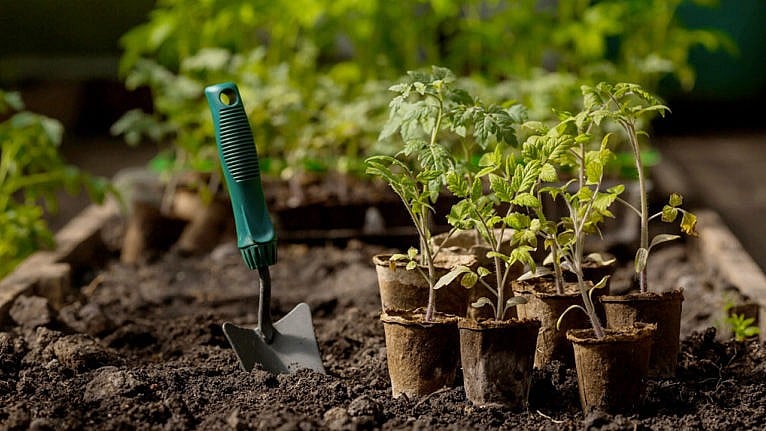Planifier un potager : par où commencer
L’été arrive bientôt, mais rien n’a encore été prévu pour son jardin de balcon ou son carré de terre ? Il est toujours temps de planifier son potager. Voici les meilleurs conseils de l’horticultrice professionnelle, Isabelle Paquin.
Photo : iStock.com
Bonne nouvelle : il est encore temps de préparer un jardin. Quand le printemps est avancé, je conseille de miser sur l’aménagement d’un potager plutôt modeste en quatre étapes simples.
1 Choisir l’endroit idéal
- Un endroit exposé au soleil plus de 6 heures par jour. Encore mieux : de 8 à 10 heures.
- Le jardin doit être à distance de deux mètres d’une haie ou de la ramure d’un arbre pour éviter la compétition avec leurs racines.
2 Déterminer les dimensions
Conseil d’ami : pensons petit pour commencer. On sous-estime souvent le temps qu’il faut consacrer à la culture potagère. Pour garder sa motivation intacte, on se limite à un potager en carré de 1,20 mètre par 1,20 mètre. On peut s’inspirer de la panoplie de plans de jardin proposée sur le Web, qu’on choisit selon l’espace dont on dispose et les récoltes convoitées. Encore plus simple : on intègre les plantes potagères à son parterre de vivaces.
Pour cultiver ses légumes sur son balcon, il suffit de quelques pots ou de bacs suffisamment profonds pour accueillir le système racinaire des plantes à maturité (minimum 30 cm x 30 cm ou 12 pouces de large), avec des trous pour assurer un drainage adéquat. Il faut savoir que les racines de nos végétaux occuperont la même superficie que la partie aérienne. Alors, faisons-leur de la place !
3 Préparer le sol
Si on cultive en pleine terre, il est essentiel d’évaluer la qualité du sol. C’est la base. On recherche une terre suffisamment drainante, pas trop légère, ni trop lourde favorisant un équilibre entre l’air et l’eau puis retenant la matière organique, ou autrement dit les nutriments.
Rares sont les terrains qui disposent d’une telle terre naturellement. Si on fait partie des chanceux, il suffit de la travailler à la truelle, puis d’ajouter du compost chaque année au moment de la plantation – selon les besoins de chaque légume ou fruit.
En cas de sol plus compact ou aride, on ne se casse pas la tête : on cultive par-dessus. On se fait livrer – en sacs ou en vrac – un mélange ⅔ de terre à jardin et ⅓ de compost marin qu’on épand sur une hauteur de 40 cm.
Pour la culture en contenant, on opte plutôt pour un substrat biologique potager. Comme chaque arrosage lessivera une partie des nutriments du sol, on prévoit l’ajout mensuel de compost et/ou d’engrais bio pour compenser.
4 Quoi semer et planter ?
Les dates approximatives des derniers gels déterminent quand et quoi semer et mettre en terre au fil des semaines.
Dans la région de Montréal, par exemple, le mois de mai est idéal pour semer les légumineuses (pois, haricots), légumes racines (betteraves, carottes, radis), légumes-feuilles (laitues, épinards, bettes à carde, choux chinois) et fines herbes (aneth, anis, carvi, coriandre, cumin, fenouil, fenugrec). Quant aux légumes-fruits (concombres, courgettes), ils préfèrent la chaleur constante du mois de juin pour germer. Comme on ressème la plupart tout au long de l’été jusqu’à l’automne, on peut acheter les quantités nécessaires auprès des semenciers québécois (en ligne) et des centres jardiniers. À Québec, on décale d’une ou deux semaines puis à Gaspé d’environ un mois.
À la mi-saison, il est toutefois trop tard pour semer certains légumes et fines herbes comme la tomate, le piment, l’aubergine, le poireau, le basilic et le persil. Heureusement, la fin mai concorde avec une pléthore de ventes de plantes comestibles et autres événements printaniers organisés par les fermes et les jardineries. C’est l’occasion de les déménager dans notre potager sans trop d’effort.
Que faire pousser sur son balcon ?
Des concombres, haricots ou pois au pied d’un treillis dans un bac de même longueur ;
Des tomates cerises, naines ou à croissance déterminée (en raison de son port compact et buissonnant). Cela évite le tralala du tuteurage, et l’assurance d’une production satisfaisante ;
On rassemble dans un bac nos fines herbes et fleurs comestibles favorites ;
On plante des piments, des mini aubergines, de la bette à carde et du chou frisé qui croissent bien en pots.
Que faire pousser en pleine terre ?
Dans une certaine mesure, on a l’embarras du choix. On opte pour ses légumes et fines herbes préférés. Les jardineries locales savent nous orienter vers des variétés adaptées au climat de notre région.
Pour les débutants, je conseille
- tomate, chou kale, bette à carde, basilic, persil, ciboulette (vivace rustique) ;
- origan, thym et sauge qui résistent à l’hiver à Montréal et à Québec ;
- semences de concombre, courgette, haricots, pois, radis, laitues à couper (mesclun), aneth.
Qu’on cultive en pleine terre ou en pots, on doit vite acheter plants et semences en ces derniers jours de mai. Je vous l’assure : ça vaut vraiment le coup de foncer !
Il n’y a pas de plus grande satisfaction que de croquer dans un radis de son potager ou de mordre dans une tomate fraîchement récoltée. Bon jardinage !
À lire aussi :
Semis : comment les préparer et s’assurer d’une belle récolte
Comment jardiner écolo








